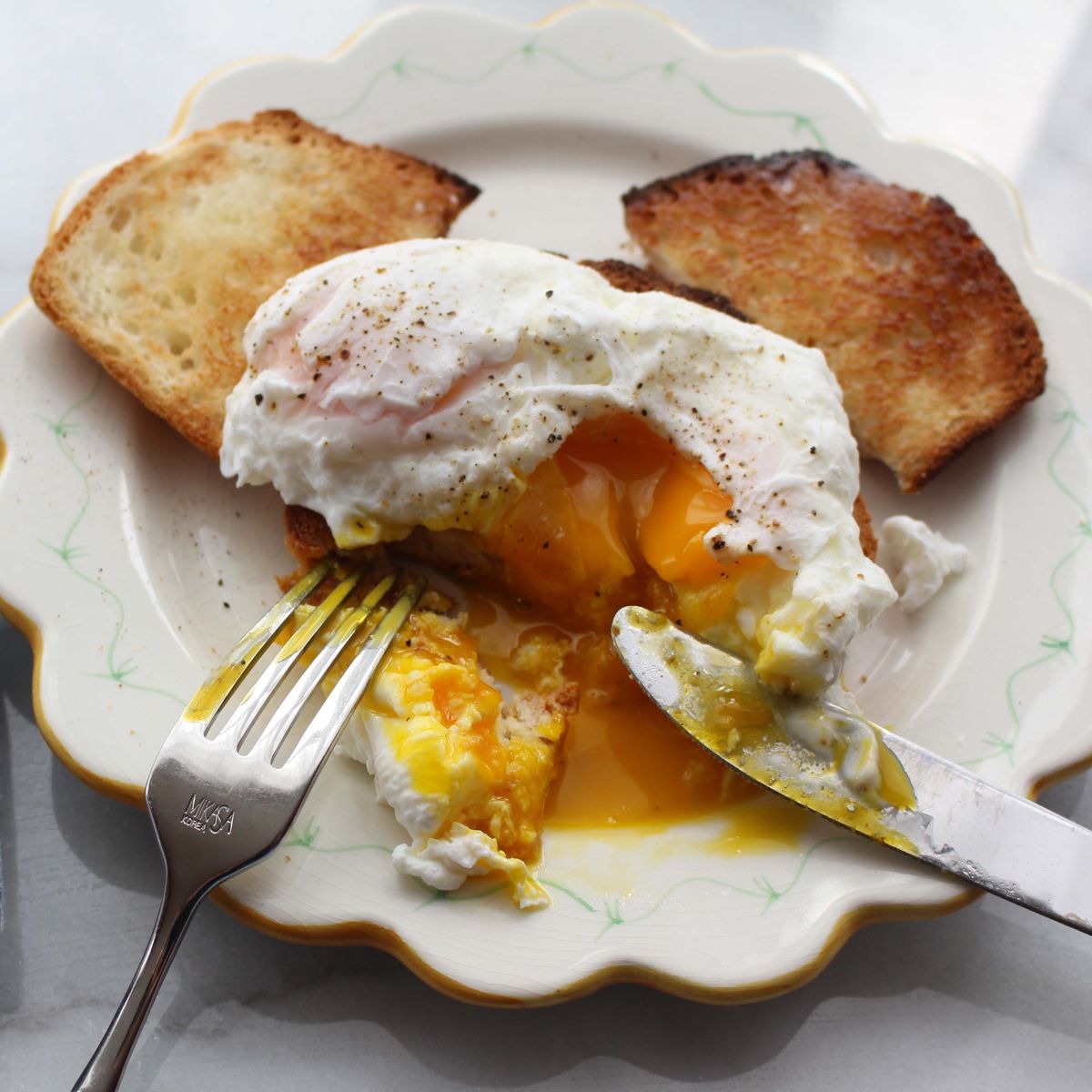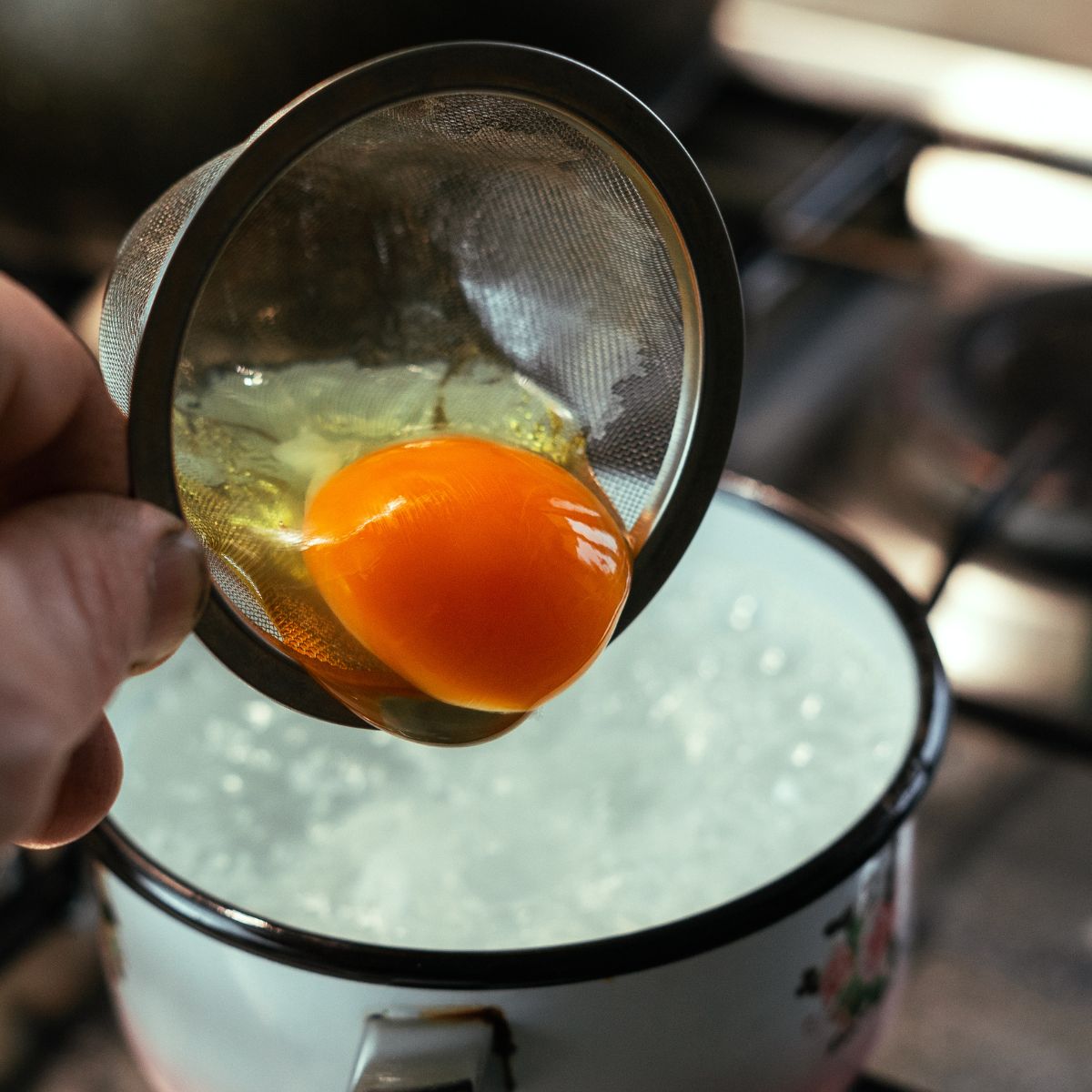Poached Eggs are easy to make, and they’re better for you than fried eggs. If you can simmer water, you can make delicious poached eggs. This easy recipe provides instructions for how to poach eggs two ways.

What Is a Poached Egg?
Poaching is a process of cooking food in hot, but not quite simmering, water, though many poached egg recipes call for the water to simmer or gently boil. A poached egg has a firmly cooked white and a wonderfully runny yolk, perfect for eating on toast.
Why You Will Love Poached Eggs
Easy and quick: The only skills you need to poach eggs are simmering water and cracking eggs. And once you slip the eggs into the water, they take less than four minutes to cook!
Healthier than fried: Scrambled, over easy, or sunny-side up, fried eggs require fat for cooking. Poached eggs, on the other hand, have no added fat because they’re cooked in water.
Yummy, runny yolks: If you like runny yolks, this recipe is for you. Cut into a poached egg and watch that deliciously golden, molten yolk ooze out. Mmm, it makes my mouth water.
Ingredients
Making poached eggs requires just two or three ingredients, depending on your chosen method.
Eggs: Use fresh eggs, if possible, as the whites will cling to the yolks better. Older eggs tend to send little tendrils into the water, which can be trimmed off after cooking for a tidier appearance.
Water: Just plain old water from the tap will do. Bring it to a boil, then lower the heat to simmering.
Vinegar: This optional ingredient helps the egg whites come together more quickly, which prevents them from separating before they fully cook and from sticking to the pot.
Equipment
Medium saucepan: Make sure to use a pot that can comfortably hold the number of eggs you want to poach. For two eggs, a medium saucepan is sufficient.
Slotted spoon: A slotted spoon is essential for removing the cooked eggs from the pot and allowing excess water to drain.
Sieve: If you choose option 1 for poaching eggs, you’ll need a fine mesh sieve to drain the raw eggs in. This helps them come out round and beautiful without the use of vinegar.
How to Make Poached Eggs

Method #1 (using a sieve):
- Place a fine mesh sieve over a bowl slightly larger than the sieve.
- Break the eggshells and gently drop the eggs, one at a time, into the fine mesh sieve. Let the eggs drain for a few minutes.
- Bring a medium pot of water to a boil.
- Gently pour the eggs from the sieve into the boiling water.
- Slowly move your slotted spoon underneath the eggs to ensure they are not sticking to the bottom.
- Reduce the heat to medium.
- When the entire egg is white (the yolk also has a white coating on it), the egg is done.
- Remove it from the water with a slotted spoon. Let it drain for a few seconds before putting it in a bowl.
- Gently drain any remaining water from the egg, and serve your poached egg over toast.
Method #2 (using vinegar):
- Bring a pot of water to a boil.
- Add the vinegar.
- Break the eggshells and carefully drop the eggs, one at a time, into the water.
- Reduce the heat to medium.
- Gently spoon the water over the eggs.
- When the entire egg is white (the yolk also has a white coating on it), the egg is done.
- Remove it from the water with a slotted spoon. Let it drain for a few seconds before putting it in a bowl.
- Gently drain any remaining water from the egg and serve it over toast.
Variations
This recipe offers two options for making lovely, round poached eggs that don’t stick to the pan. The first option calls for a fine mesh sieve. Crack the eggs into a sieve and allow them to drain before gently slipping them into the boiling water. The eggs will come out perfectly round and beautiful.
For the second option, you crack the eggs directly in the water. First, though, you add a splash of vinegar to the water to encourage the whites to coagulate quickly, which means the egg sticks to itself and not to the pan.
Storage
Poached eggs are best eaten immediately, but they can be made beforehand. This is especially handy if you need to make a lot of poached eggs to feed a crowd. If you want to work 30 minutes ahead, place the cooked eggs in a bowl of lukewarm water until serving time. Then, gently dunk them back in the simmering water for 30 to 60 seconds to reheat.
To prepare poached eggs the day before, put them directly into a bowl of ice water as soon as they finish cooking, then place the whole container in the fridge. Again, reheat the eggs in simmering water for 30 to 60 seconds.
Serving Suggestions

These eggs are good by themselves or over toast or English muffins. They are even delicious over pancakes or used in Eggs Benedict. Be sure to drain them well before you put them on your toast or muffin!
FAQs
Poached eggs take an average of two to three minutes to cook. Keep an eye on your egg as it cooks, and take notes the first couple of times you poach eggs. You’ll get a feel for exactly how long to leave the egg in the water for your ideal poached egg.
Yes! While you will likely get the prettiest eggs by cooking them one at a time, you can certainly slip multiple eggs into the simmering water together. Just select a pot large enough to accommodate the number of eggs you want to cook.
Poaching, by definition, requires the water to be just under a simmer. However, many recipes (including this one) call for simmering water. Bring your water to a boil, then lower the temperature to a simmer before slipping in the eggs.
Knowing how to poach an egg properly, you can wow guests with a fancy breakfast or brunch. Only you will know just how easy it was to make!
More Ways to Cook Eggs
- Elegant Coddled Eggs
- How to Make Fried Eggs
- How to Make Delicious Basted Eggs Every Time
- Soft Boiled Egg
- How to Make Hard-Boiled Eggs
- Hard Cooked Eggs Florentine

How to Make Poached Eggs
Ingredients
- 2 eggs
- 1 Pot of water 4 cups
- 1 tablespoon white vinegar optional
Instructions
Method #1 (Using a Sieve):
- Place a fine mesh sieve over a bowl that is slightly larger than the sieve.
- Break the eggshells and gently drop the eggs, one at a time, into the fine mesh sieve. Let the eggs drain a few minutes.
- Bring a medium pot of water to a boil.
- Gently pour the eggs from the sieve into the boiling water.
- Slowly move your slotted spoon underneath the eggs to make sure they are not sticking to the bottom.
- Reduce the heat to medium.
- When the entire egg is white (yolk also has a white coating on it), the egg is done.
- Remove it from the water with a slotted spoon. Let it drain for a few seconds before putting it in a bowl.
- Gently drain any remaining water from the egg, and serve your poached egg over toast.
Method #2 (No Sieve):
- Bring to pot of water to a boil.
- Add the vinegar.
- Break the eggshells and carefully drop the eggs, one at a time, into the water.
- Reduce the heat to medium.
- Gently spoon the water over the eggs.
- When the entire egg is white (yolk also has a white coating on it), the egg is done.
- Remove it from the water with a slotted spoon. Let it drain for a few seconds before putting it in a bowl.
- Gently drain any remaining water from the egg, and serve it over toast.
Notes
Nutrition

Kathy acquired the blog, Recipe Idea Shop in 2024. She was raised on a farm in Arkansas where having a big garden and good food to eat was the norm. She shares recipes for homemade comfort food and new trending dishes.
Kathy began her blogging journey in 2011 when she founded PetticoatJunktion.com, a home décor blog focused on repurposing and upcycling furniture, and thrift store finds.

